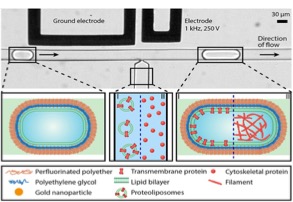Nanofabulous Seminar: Matter to Life: Bottom-Up Assembly of Synthetic Cells
 The evolution of cellular compartments for spatially and temporally controlled assembly of biological processes was an essential step in developing life by evolution. Synthetic approaches to cellular-like compartments are still lacking well-controlled functionalities, as would be needed for more complex synthetic cells. With the ultimate aim to construct life-like materials such as a living cell, matter-to-life strives to reconstitute cellular phenomena in vitro – disentangled from the complex environment of a cell. In recent years, working towards this ambitious goal gave new insights into the mechanisms governing life. With the fast-growing library of functional modules assembled for synthetic cells, their classification and integration become increasingly important.
The evolution of cellular compartments for spatially and temporally controlled assembly of biological processes was an essential step in developing life by evolution. Synthetic approaches to cellular-like compartments are still lacking well-controlled functionalities, as would be needed for more complex synthetic cells. With the ultimate aim to construct life-like materials such as a living cell, matter-to-life strives to reconstitute cellular phenomena in vitro – disentangled from the complex environment of a cell. In recent years, working towards this ambitious goal gave new insights into the mechanisms governing life. With the fast-growing library of functional modules assembled for synthetic cells, their classification and integration become increasingly important.
We will discuss strategies to reverse-engineer and recombine functional parts for synthetic eukaryotes, mimicking the characteristics of nature’s own prototype. Particularly, we will focus on large outer compartments, complex endomembrane systems with organelles and versatile cytoskeletons as hallmarks of eukaryotic life. Moreover, we identify microfluidics and DNA nanotechnology as two highly promising technologies which can achieve the integration of these functional modules into sophisticated multifunctional synthetic cells.

Prof Joachim P. Spatz
Max Planck Institute for Medical Research, Heidelberg, Germany
http://www.mpimf-heidelberg.mpg.de/en
11:00am, 9/11/2023
Melbourne Centre for Nanofabrication
151 Wellington Road, Clayton, 3168
Zoom link: click here
Meeting ID: 863 5742 5847 Passcode: 074707


